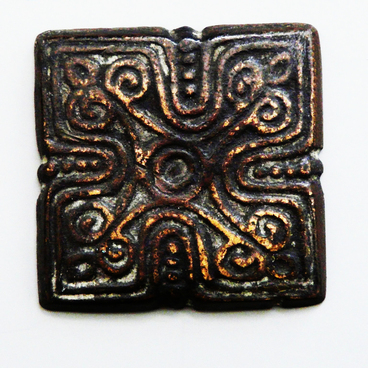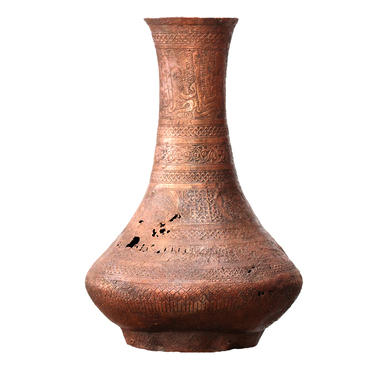‘Maklasheevsky Horseman’ is a bronze lock-amulet in the shape of a man. He is sitting on top of a mythical animal. The rider got such a name after the name of the settlement where it was found — Maklasheevsky. This complex archaeological site includes settlements of the early Iron Age and the early Middle Ages. It is located on the bank of the Kuibyshev reservoir on the border of the Republic of Tatarstan and the Ulyanovsk region.
The composite figure is dated the 11th or 12th century. The artefact consists of two parts that are not attached. The first part is a sculpture of an animal with short but muscular paws. This animal resembles a snow leopard but compared to the real inhabitant of the mountains, the bronze one is depicted with short horns. The horns are a sign of exclusivity. The Huns, the ancient inhabitants of Central Asia, had prefixes ‘four-horned’ and even ‘six-horned’ in the names of their nobles. Circular ornamentation reflects the color of the animal. The multicolored snow leopard (ala-bars) was considered a sacred animal in shamanism.
Locks with a figure of a leopard are also found without a rider. In this specimen, the main part is a hollow figure depicting a man. The face is round with a pointed chin and a massive nose. The eyebrows are depicted with a broad band connected to the nose. The right eye is marked by a dimple and gives the impression of being drained. The rider is missing his right arm below the elbow and his right leg below the knee. In the center of the figure is a through-hole into which the shackle of the figure lock is threaded.
The unusual artifact is not just a sample of jewelry. Scientists have found out that the find illustrates one of the legends of the origin of Turkic tribes.
One of the clans of the Hunnu tribe was attacked by enemies and completely exterminated. Only a 10 year old boy survived. They cut off parts of his right arm and leg, poked out his eye, and left him to die alone in a swamp. The boy was rescued by a wolf. After 10 years, the mature boy was killed, and the wolf found her refuge in the mountains. There she gave birth to ten sons. One of them was Ashina, who, according to ancient myths, became the ancestor of the Turkic people.
The composite figure is dated the 11th or 12th century. The artefact consists of two parts that are not attached. The first part is a sculpture of an animal with short but muscular paws. This animal resembles a snow leopard but compared to the real inhabitant of the mountains, the bronze one is depicted with short horns. The horns are a sign of exclusivity. The Huns, the ancient inhabitants of Central Asia, had prefixes ‘four-horned’ and even ‘six-horned’ in the names of their nobles. Circular ornamentation reflects the color of the animal. The multicolored snow leopard (ala-bars) was considered a sacred animal in shamanism.
Locks with a figure of a leopard are also found without a rider. In this specimen, the main part is a hollow figure depicting a man. The face is round with a pointed chin and a massive nose. The eyebrows are depicted with a broad band connected to the nose. The right eye is marked by a dimple and gives the impression of being drained. The rider is missing his right arm below the elbow and his right leg below the knee. In the center of the figure is a through-hole into which the shackle of the figure lock is threaded.
The unusual artifact is not just a sample of jewelry. Scientists have found out that the find illustrates one of the legends of the origin of Turkic tribes.
One of the clans of the Hunnu tribe was attacked by enemies and completely exterminated. Only a 10 year old boy survived. They cut off parts of his right arm and leg, poked out his eye, and left him to die alone in a swamp. The boy was rescued by a wolf. After 10 years, the mature boy was killed, and the wolf found her refuge in the mountains. There she gave birth to ten sons. One of them was Ashina, who, according to ancient myths, became the ancestor of the Turkic people.



